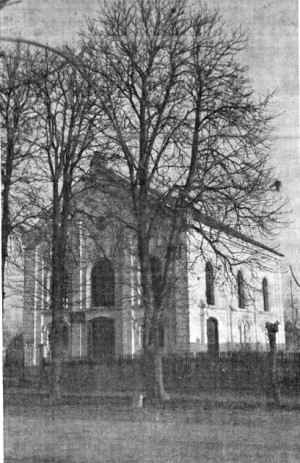 |
The synagogue
48°00' 20°55'
Translation of the “Ónod” chapter from
Pinkas Hakehillot Hungary
Edited by: Theodore Lavi
Published by Yad Vashem
Published in Jerusalem, 1975
Our sincere appreciation to Yad Vashem
for permission to put this material on the JewishGen web site.
This is a translation from: Pinkas Hakehillot Hungary: Encyclopedia of Jewish Communities, Hungary,
Edited by Theodore Lavi, published by Yad Vashem, Jerusalem. Pages 143-144.
JewishGen, Inc. makes no representations regarding the accuracy of
the translation. The reader may wish to refer to the original material
for verification.
JewishGen is not responsible for inaccuracies or omissions in the original work and cannot rewrite or edit the text to correct inaccuracies and/or omissions.
Our mission is to produce a translation of the original work and we cannot verify the accuracy of statements or alter facts cited.
[Page 143]
Translated by Jerrold Landau
Ónod is a town in the region of Borsod, near Sajó,
nine kilometers from Miskolc. Its population in 1941 was 2,369.
Jewish Population
| Year | Population |
| 1727 | 1 (family) |
| 1735 | 31 (individuals) |
| 1747 | 42 |
| 1830 | 72 |
| 1880 | 159 |
| 1930 | 184 |
Until the Second World War
At the foot of the wall of the old palace of the estate owner Rákóczi, there is a monument with a Hebrew inscription, dated from the middle of the 18th century. From this, we see that there was already a community at that time in the place or close by.
[Page 144]
|
|
The synagogue |
Most of the Jews of Ónod were grain merchants. The minority were estate owners. One owned a large flourmill that employed many people.
The community was dependent on Nemesbükk until 1860, when it became independent. From 1885, the following communities became dependent on it: Nyék, Ládházá, Belsõbõcs, Külsõbõcs, Sajólád, Sajópetri, Alsó-zsolca, Felsõzsolca, and later also the communities: Mohi, Sajószeged, Tizapalkonya, Tiszakürt, Hejõbaba, Nemesbükk, Parasztbükk, Hejõszakáld, Hejõszalonta, Hejõkeresztúr, and others.
There was a house of worship there already in 1830. The splendid synagogue was built in 1883. There was also a school there (liquidated in 1923, when the government support was canceled).
There were also several social institutions in Ónod. The most important of them were the Keren Kayemet (Jewish National Fund), and Ezrat Dalim (assistance for the poor).
From among the rabbis of Ónod, it is fitting to note: Rabbi Meir Schick (1892-1942), who founded an educational institution called “Talmud Torah Umelacha” [Study of Torah and Trade] in 1910 – a yeshiva in which they also studied tailoring, carpentry, and shoemaking; his son-in-law Rabbi Feivel Fülõp Donáth (1942-1944) who served as a military rabbi at the rank of high captain already years prior to that. He perished in the Holocaust.
Thirty-one Jews of Ónod participated in the First World War, five of whom fell on the front.
In 1919, during the “White Terror”, the Jews of Ónod suffered from harsh anti-Semitic action. The son of rabbi Schick, who was 21 years old at the time (and who served as the chairman of the Orthodox rabbinate of Hungary after the Second World War), was imprisoned on a false libel. He was exonerated through the testimony of local Christian notables.
The Holocaust
In 1938, with the proclamation of the separation laws, many Jews of Ónod were displaced from their livelihoods. In 1941, the youth were sent to various forced labor camps. Most of them perished in Ukraine and other places.
With the Nazi conquest in 1944, the communal leaders were arrested sand beaten cruelly. In the middle of May, all the Jews of Ónod were transferred to the Diósgyõr Ghetto. Most of the men up to the age of 48 who still remained there were sent to forced labor camps, where they all perished. The rest of the Jews of Ónod were loaded onto wagons on June 10, and brought to Auschwitz on June 14. Some of them were murdered immediately, and the rest were transferred to Ellendorf, where they were put to work in the ammunition factory. Others were transferred to Bergen-Belsen.
After the war, about ten men returned, most of them from forced labor camps, and 10 young women returned from Auschwitz. The community was not reconstituted. The synagogue was destroyed, and a Protestant church was built on its ruins.
Y.K.
Bibliography:
Yad Vashem Archives E 7-4/174
Mon. Hun. Jud., VII, pp. 125, 260, 734.
Magyar Zsidó Almanach, 1911, p. 267.
Zsidó Lexikon, pp. 662-663.
Jungreisz, E.: Egy Magyar ortodox rabbi életmüve.
… Uj Kelet, 1963, no. 27, p. 17.
JewishGen, Inc. makes no representations regarding the accuracy of
the translation. The reader may wish to refer to the original material
for verification.
JewishGen is not responsible for inaccuracies or omissions in the original work and cannot rewrite or edit the text to correct inaccuracies and/or omissions.
Our mission is to produce a translation of the original work and we cannot verify the accuracy of statements or alter facts cited.
 Encyclopaedia of Jewish Communities. Hungary
Encyclopaedia of Jewish Communities. Hungary
 Yizkor Book Project
Yizkor Book Project
 JewishGen Home Page
JewishGen Home Page
Copyright © 1999-2024 by JewishGen, Inc.
Updated 14 Apr 2018 by MGH